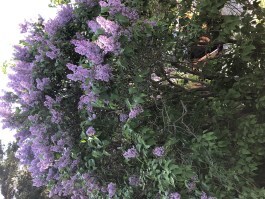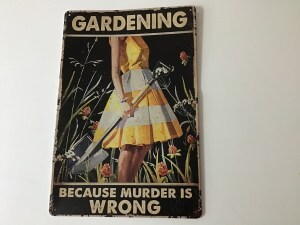Oh this glorious, glorious spring!
Emily Dickinson (1830-1886)
A little Madness in the Spring
Is wholesome even for the King,
But God be with the Clown –
Who ponders this tremendous scene –
This whole Experiment of Green –
As if it were his own!
Kate Flora: Recently someone said that if your gardens don’t look good in May, they’ll

It’s a splendid year for lilacs
never look good. I don’t know if this is true. A visit to the Coastal Maine Botanical Gardens at any season is an experience filled with delight. But yes, right now my gardens are looking quite wonderful, despite all the losses caused by winter weather. They present a dilemma which must be common to all writers: how can we stay at our desks, toiling away on our books, when the world so adamantly wants us to come outside?
In my more disciplined years, I would make deals with myself: I was allowed to garden for an hour early in the day, before it got hot, and for the rest of the day, I was chained to my desk. Sometimes, when I was deeply in story but the gardens needed attention, it would be a ten hour day with two hours allowed in the garden. Once, when I was late, I confess that I was out there gardening in my nightgown, and got a nasty spider bite.
Recently, I have found that I lack the energy and the discipline to work at either gardening or writing for as long. Since the mosquitoes have come out in force. I figure that if I’m going to wear my tick and mosquito repellant clothes and spray myself, I might as well stay out there longer. After so many years at the keyboard, I do have faith that books will get done, just more slowly. As for the gardens? I never get the work done and I expect I never will.
 At times in the past, I’ve blogged about how gardening is like writing a book. You have to take a lot on faith–that that inspiring idea will, if nurtured, grow into a novel, just as that teeny shrub, if nurtured, will one day be a gorgeous bush buzzing with bees. Organizing the colors and textures and heights of plants is also a lot like telling a story. Words, like plants, have to be chosen to best illuminate the story, make the characters come alive, or move the action along. And as with writing a book, when you’re working on one patch at a time, you cannot see the whole, yet you have to have faith it will come together in the end.
At times in the past, I’ve blogged about how gardening is like writing a book. You have to take a lot on faith–that that inspiring idea will, if nurtured, grow into a novel, just as that teeny shrub, if nurtured, will one day be a gorgeous bush buzzing with bees. Organizing the colors and textures and heights of plants is also a lot like telling a story. Words, like plants, have to be chosen to best illuminate the story, make the characters come alive, or move the action along. And as with writing a book, when you’re working on one patch at a time, you cannot see the whole, yet you have to have faith it will come together in the end.
The way that writers see the world is a subject I return to fairly often, as you faithful readers may have noticed. During this season, I love watching the tiny shoots of green grow taller every day until they become large, lush plants with the promise of flowers ahead. I prowl along the edge of the perennial bed, looking for those tiny volunteers that have escaped and are trying to survive in the grass of the lawn. I dig them up and find them new places to grow.
What do these shoots of green that seem to change overnight teach me? Perhaps about

Forty years ago, this was a tiny shrub. And I was writing my first mystery
how this is much like the way a book begins. First it is just a tiny idea, and by pondering on it, it gradually grows to become the plot of a book. Like those tiny shoots, a book idea will need attention. It will need to be fertilized with essential questions like: What is this about and why is this book about this particular set of characters? It will need space to grow to it’s full size, in the brain and on the page. It will need the unnecessary ideas to be weeded out so that the plant can grow. Sometimes it will need to be cut back to make the plot fuller and less straggly.
Like a tender plant needing a gardener to tend it, a book idea needs the author to figure out what the story needs to make it grow into a successful book. What will fertilize it? How much water (or perhaps, in an authors case, how much alcohol, or time, or sweat) will it need to make it grow and achieve its full potential? What kind of research must be done to make the setting, characters, and plot feel authentic to a reader. And as in a successful garden, the plant, like a protagonist or antagonist, will need complimentary plants around it to illuminate it and compliment it. What complimentary shapes and sizes and colors will enhance a perennial bed? What sidekicks, bosses, clients, or love interests will shape and enhance your protagonist? What plants, like antagonists, may need to be managed so they don’t dominate?

A most appropriate Mother’s Day gift
And of course, as in any garden there will be the weeds, roots, rocks, and pests, that will want to thwart successful growth to a mature plant, in a book there will be the obstacles internal and external, and the antagonists, both natural and human, which must be overcome in order for the story to come to a successful conclusion where order is restored to the world.
Finally, like a well-told story that is coming to its conclusion, there is the moment in the garden when that plant has been successfully fertilized, watered, and protected from weeds and insects, and it fulfills its purpose by producing colorful leaves and glorious flowers. With the book, that is the moment when the writer types: The End, and sits back with a smile of satisfaction.
Of course, just as in a well-tender garden, the job isn’t finished. Plants need to be divided, cut back, or shuffled around to new locations. In the book, typing: The End is not the end. It is simply the beginning of the next process–revision.
May your words flow and your garden grow!
Lea Wait's Blog
- Lea Wait's profile
- 506 followers



